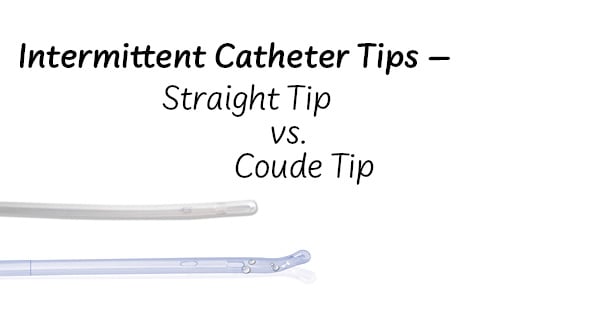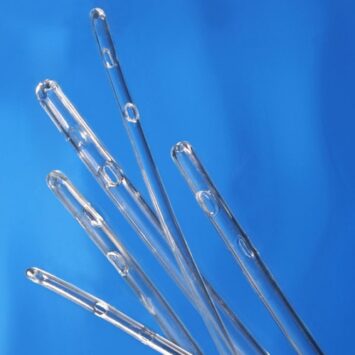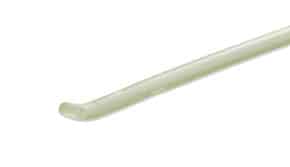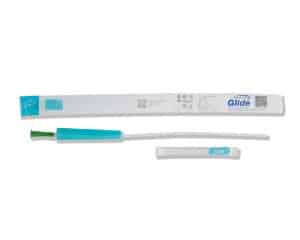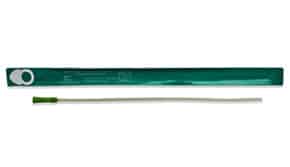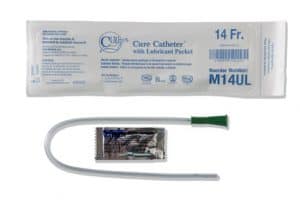An intermittent catheter is a hollow tube placed in the urinary tract to allow urine to drain from the body. Intermittent catheters come in various sizes, materials, and styles based on why the urinary catheter is needed. It may take trying different types of catheters before finding what is the most comfortable. There are two main styles of intermittent catheter tips: straight tip and coude tip. We will discuss the difference between these two catheter tips and why either is used.
Straight Tip Intermittent Catheter
An intermittent catheter with a straight tip is considered the standard and used by the majority. The catheter is straight from one end to the other with no curvature. Straight-tip intermittent catheters can be made with various materials such as rubber, silicone, latex, or PVC and can be pre-lubricated or have a hydrophilic coating. Each catheter features drainage eyelets at the end to facilitate emptying urine into an attached urinary drainage bag or the toilet.
Intermittent catheters with a straight tip are an inexpensive option and easy to use. They are available in various lengths to accommodate the female and male anatomy and even come in pediatric sizes. If you experience pain or discomfort when inserting a straight-tip catheter, a coude tip catheter may be a better solution.
Coude Tip Intermittent Catheter
A coude tip intermittent catheter may be recommended and prescribed by a health care provider if pain is experienced when using a straight-tip catheter. Similar in function to a straight-tip catheter, a coude-tip catheter features a slightly bent or angled tip. The coude tip allows the catheter to enter the urethra easier and maneuver around obstructions such as scar tissue or an enlarged prostate.
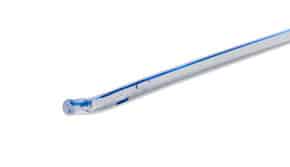 Within the coude catheters, there are two variations. The coude olive tip intermittent catheter is slightly curved and features a small round bulb at the end. This rounded bulb helps navigate through small obstructions and blockages. The Tiemann tip intermittent catheter has a bent tip that is thinner and longer than the standard coude tip catheter. The Tiemann tip catheter is excellent for those with narrow urethras and tiny openings through the urethra into the bladder.
Within the coude catheters, there are two variations. The coude olive tip intermittent catheter is slightly curved and features a small round bulb at the end. This rounded bulb helps navigate through small obstructions and blockages. The Tiemann tip intermittent catheter has a bent tip that is thinner and longer than the standard coude tip catheter. The Tiemann tip catheter is excellent for those with narrow urethras and tiny openings through the urethra into the bladder.
Choosing Which Catheter is Right for You
Keeping an open relationship with your urologist is beneficial in determining which catheter is best suited for your unique needs. They can offer you alternate options by letting your doctor know if you are experiencing pain or discomfort. Intermittent self-catheterization should never be painful, and your doctor’s job is to make the process as comfortable and safe as possible. So, make sure you are open and honest with your doctor about your experience.
The Importance of Lubricating an Intermittent Catheter
Using a catheter should never be painful, and making sure to use a quality lubricant can be helpful. Straight-tip and coude tip intermittent catheters are also available as hydrophilic and pre-lubricated options that can provide even greater comfort. Ensuring it is well-lubricated no matter the type of catheter can make all the difference.
To learn more about catheter lubricant, check out our blog, “How to Lubricate Your Catheter.”
With a bit of practice and instruction from your doctor, using an intermittent catheter, no matter the type, should be comfortable and easy. If you need assistance choosing the type of catheter your urologist recommends or has prescribed, we have Product Experts available to help. Give us a call at 800-777-1111, and we will happily assist.
Popular Intermittent Catheters

